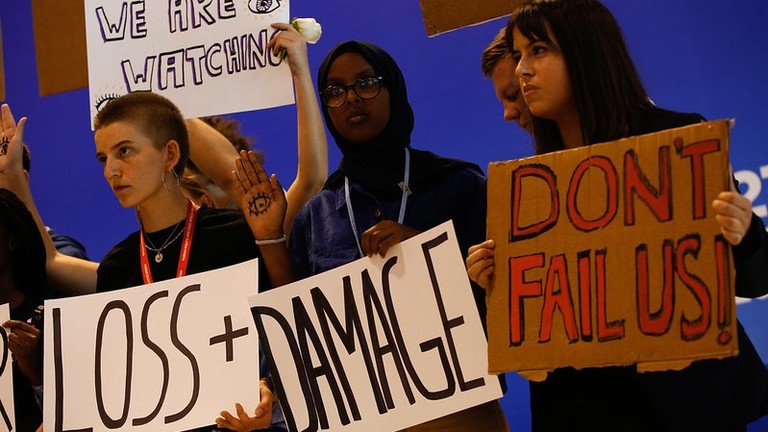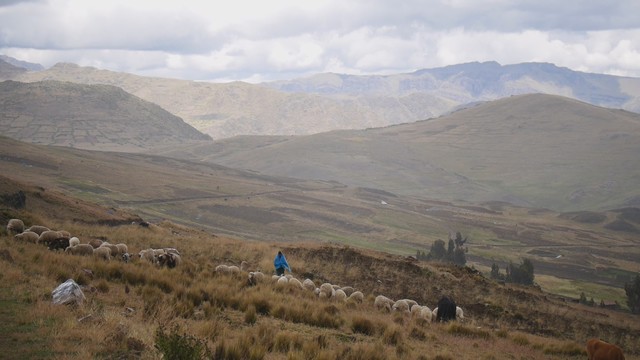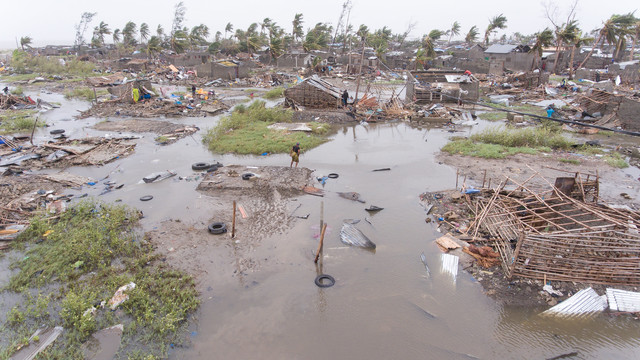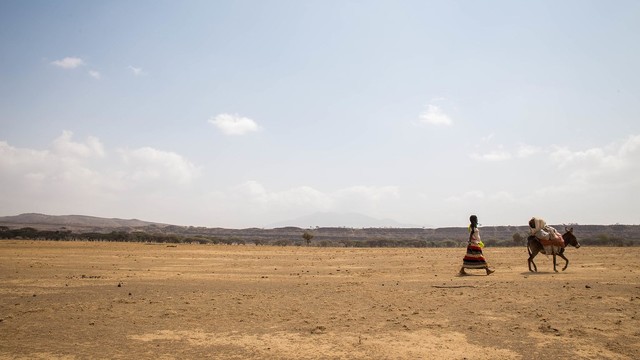COP27: were the climate-vulnerable finally heard in Egypt?
The 27th Conference of the Parties (COP27) of the UNFCCC hosted in Egypt concluded with some progress, but above all the feeling that the highest-emitting countries in the negotiations have not yet recognised the full measure of the climate urgency. Pape Lamine Diouf and Lina Yassin take stock of the event’s main outcomes and what they mean for the least developed countries.



A group of young people demonstrating at COP27, in Egypt (Photo: UNclimatechange, via Flickr, CC BY-NC-SA 2.0)
After four years of hosting COPs in Europe with some ambition but no sun, having the COP return to Africa raised hopes that developing countries’ demands, mainly on adaptation and loss and damage, would be at the centre of the conference.
Following incremental progress but limited ambition at COP26 in Glasgow, developing and least developed countries had to make sure that COP27 ended with tangible outcomes and delivered climate justice to those who have contributed the least to the climate crisis but suffer the most from it.
As usual during the opening ceremonies of these conferences, world leaders competed in presence and promises. However, beautiful speeches can sometimes be out of step with the realities in the negotiating rooms, where optimism gives way to disappointment.
Loss and damage: some progress at long last!
On Sunday morning, as the conference concluded nearly two days late, celebrations started in the venue despite exhaustion and lack of sleep, with the historic announcement of the establishment of a fund for responding to loss and damage. A decades-long demand from developing countries has finally been accepted.
And while some argue that COP27 will be remembered as a failure, least developed countries will never forget this moment and the hard work it took to get there.
Agreeing to a fund is the first step. A lot of work remains for the transitional committee that will need to make recommendations on the structure and modalities of the fund.
Figuring out ways to ensure the fund has adequate funding that can quickly and effectively be disbursed to those who need it when they need it will not be easy, and lessons must be learnt from existing funds like the Green Climate Fund, which was also set up through a transitional committee. The transitional committee will deliver its report at COP28.
Adaptation’s snail pace
“Too little, too slow” is how the UN Environment Programme’s Adaptation Gap Report, published shortly before COP27, described the global effort to adapt to the impacts of climate change.
In Sharm el-Sheikh, the adaptation agenda proved challenging, and all the items composing it were carried to the second week to be discussed by ministers.
However, one significant step in this agenda has been the establishment of a framework for the Global Goal on Adaptation, which aims to refine the details of the goal and guide its work moving forward.
Another win for the Least Developed Countries (LDC) Group, although less reported, was the inclusion of a paragraph in the final text of the ‘Matters related to LDCs’ agenda, recognising the challenges that least developed countries face in implementing their national adaptation plans (NAPs) and the need for enhanced support. This was an important demand for the group, as many least developed countries with NAPs have made limited to no progress in implementing their plans so far.
As for the promised doubling of adaptation finance by 2025, it remains off track, and the UNEP report highlights that current adaptation finance to developing countries is still five to ten times lower than it needs to be. Although the LDC Group had expected a stronger outcome on this matter, the final decision text did request an annual report to show progress on the pledge.
Still not there on finance
As with all COPs, climate finance remains the most challenging part of the negotiations. Over the years, developed countries have become more reluctant to talk finance, while their pledges and contributions still amount to a tiny fraction of what least developed countries need.
One of the biggest issues was the mobilisation of the promised US$100 billion per year by 2020. Two years late, this remains an ongoing conversation with not much progress. United States climate envoy John Kerry stated that reaching almost 90% of the target should be celebrated because, in school, if you got “90-something” on a test, you would be happy. While this is true, as far as we are aware, no one in school gets 13 years to revise for one test! And the consequences of this slow progress are already proving catastrophic for millions of people.
COP27 also featured a continuation of the technical discussions on the new finance goal, which is meant to replace the $100 billion goal from 2025. No decision was expected from this item in Egypt, and countries even failed to agree on a definition for climate finance, leaving more work to be done further down the line.
Is 1.5 still alive?
After many COPs without any decision to strengthen mitigation efforts and thereby stay under 1.5°C of global warming, it wasn’t until last year that Parties finally adopted the Glasgow Climate Pact, which included the establishment of a work programme to intensify climate ambition urgently. The Glasgow Pact also for the first time included in a final text mention of the need to phase out the use of coal and inefficient fossil fuel subsidies.
However, in Sharm, initial optimism quickly faded as we noted differences on the conceptual orientation of the mitigation work programme. While some groups, including the LDC Group, focused on the need to peak emissions as soon as possible and close the emissions gap, a number of developing countries instead sought to redefine some of the fundamental principles laid out in the programme, such as the principle of common but differentiated responsibility.
Ultimately, both sides agreed a decision to scale up emissions reduction efforts before 2030 and set up a process to explore issues and identify opportunities and gaps for reducing emissions. But LDCs and several other Parties expressed their concern about a worrying lack of momentum towards keeping the 1.5°C goal alive beyond COP27.
Beyond COP27
Where do we go from here? This is the question that we will all be travelling to COP28 next year to answer. Fortunately, the Paris Agreement established the Global Stocktake (GST), a process to assess progress and inform Parties of what is needed to increase ambition.
The GST’s first cycle started this year and will conclude at COP28. This process is critical for the LDCs because the GST will be instrumental in realising the objectives of the Paris Agreement and enabling ambitious climate action and strengthened international cooperation.
Just like everything else in the UNFCCC system, the ability of the GST process to deliver effectively will depend entirely on the willingness of countries to engage openly.
Despite a challenging geopolitical context, COP27 managed to push for some results, but the rate of progress remains much too slow to address the urgency of the climate crisis. Success in the negotiation process is like a mosaic: we need to see the whole picture across multiple conferences, and COP28 must continue to contribute to the direction to travel.




